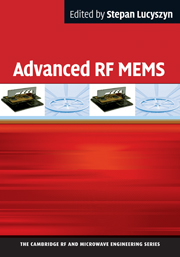Book contents
- Frontmatter
- Dedication
- Contents
- List of Contributors
- Preface
- List of Abbreviations
- 1 Introduction
- 2 Electromechanical modelling of electrostatic actuators
- 3 Switches and their fabrication technologies
- 4 Niche switch technologies
- 5 Reliability
- 6 Dielectric charging
- 7 Stress and thermal characterisation
- 8 High-power handling
- 9 Packaging
- 10 Impedance tuners and tuneable filters
- 11 Phase shifters and tuneable delay lines
- 12 Reconfigurable architectures
- 13 Industry roadmap for RF MEMS
- Author biographies
- Index
- References
12 - Reconfigurable architectures
Published online by Cambridge University Press: 05 February 2014
- Frontmatter
- Dedication
- Contents
- List of Contributors
- Preface
- List of Abbreviations
- 1 Introduction
- 2 Electromechanical modelling of electrostatic actuators
- 3 Switches and their fabrication technologies
- 4 Niche switch technologies
- 5 Reliability
- 6 Dielectric charging
- 7 Stress and thermal characterisation
- 8 High-power handling
- 9 Packaging
- 10 Impedance tuners and tuneable filters
- 11 Phase shifters and tuneable delay lines
- 12 Reconfigurable architectures
- 13 Industry roadmap for RF MEMS
- Author biographies
- Index
- References
Summary
Introduction
The focus of R&D activities in RF microsystems has been mostly at component and circuit levels. Component and circuit performances have tried to improve those of their semiconductor counterparts. This work has been successful in many cases. From the systems level point of view, RF MEMS technology offers improvements in tuning range, power linearity, insertion loss and scalability compared with other technologies. Tuning range relates to high-capacitance ratio switches, rather than continuous tuneability; a limitation that still exists with RF MEMS varactors. However, systems level improvements and new architectures can take full advantage of RF MEMS technology. Proposals for new architectures are continually being presented, but limited demonstrations have been reported to date.
For many applications, more and new functionalities are being sought by radio front-ends, to meet size and cost downscaling pressures. For example, several radios can be integrated into handsets and software-defined radio (SDR) concepts have been implemented in several applications. RF MEMS technology can be one of the enabling technologies to allow these new concepts to be implemented. The use of RF MEMS technology can offer the largest benefits when there are no directly competing technologies and in-high performance applications.
- Type
- Chapter
- Information
- Advanced RF MEMS , pp. 343 - 358Publisher: Cambridge University PressPrint publication year: 2010



